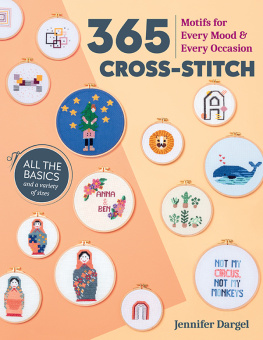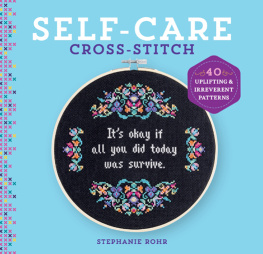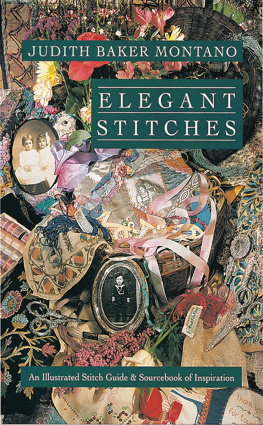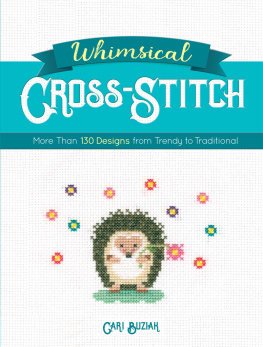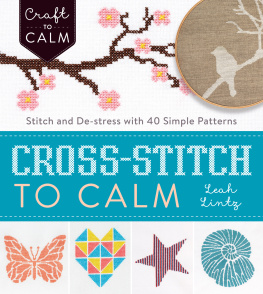Margaret Agutter - Cross Stitch Patterns
Here you can read online Margaret Agutter - Cross Stitch Patterns full text of the book (entire story) in english for free. Download pdf and epub, get meaning, cover and reviews about this ebook. year: 2016, publisher: Read Books Ltd., genre: Romance novel. Description of the work, (preface) as well as reviews are available. Best literature library LitArk.com created for fans of good reading and offers a wide selection of genres:
Romance novel
Science fiction
Adventure
Detective
Science
History
Home and family
Prose
Art
Politics
Computer
Non-fiction
Religion
Business
Children
Humor
Choose a favorite category and find really read worthwhile books. Enjoy immersion in the world of imagination, feel the emotions of the characters or learn something new for yourself, make an fascinating discovery.

- Book:Cross Stitch Patterns
- Author:
- Publisher:Read Books Ltd.
- Genre:
- Year:2016
- Rating:4 / 5
- Favourites:Add to favourites
- Your mark:
- 80
- 1
- 2
- 3
- 4
- 5
Cross Stitch Patterns: summary, description and annotation
We offer to read an annotation, description, summary or preface (depends on what the author of the book "Cross Stitch Patterns" wrote himself). If you haven't found the necessary information about the book — write in the comments, we will try to find it.
Cross Stitch Patterns — read online for free the complete book (whole text) full work
Below is the text of the book, divided by pages. System saving the place of the last page read, allows you to conveniently read the book "Cross Stitch Patterns" online for free, without having to search again every time where you left off. Put a bookmark, and you can go to the page where you finished reading at any time.
Font size:
Interval:
Bookmark:
PATTERNS
BY
MARGARET AGUTTER
Author of Modern Patchwork
With illustrations by the author

Frontispiece
QUEEN MARYS CARPET
CROSS stitch is one of the oldest and simplest of embroidery stitches. It has been used in peasant needlework all over the world, to decorate homespun linens with simple borders and intricate all-over patterns. These decorations give an air of gaiety and charm to the homely garments worn by country men and women in their daily lives.
It was the favourite stitch of the young seamstress of the seventeenth century, working her neat and beautiful sampler; indeed, at that time it was more generally known as Sampler Stitch, and was looked upon as the simplest and most necessary stitch in the small needlewomans repertoire. She used it to work her alphabet and numbers, and for the portrait of My dear father in his scarlet coat and feathered hat, and finally signed her name in minute stitches, adding proudly Aged seven years.
The choice of pattern is perhaps more important in canvas embroidery than in any other form of needlework. The necessary convention of the squared outline, determined by the counted threads of the canvas mesh, gives the work a characteristic angular charm that may be completely lost if unsuitable patterns are attempted.
This book has been planned in the hope that needle-women will find inspiration in the illustrated patterns and borders, adapting them to the purposes of their embroidery, and working out, their own designs using the ideas given here as a basis. It is not difficult to make new designs, given plenty of squared paper and a few brightly coloured pencils. And it is delightful to be independent of transfers and elaborate charts, and to produce a piece of embroidery that is at once individual and personal in design as well as in workmanship.
Many of the patterns suggested here for each type of needlework are taken from old embroideries. They are shown worked out in cross stitch, but the principle of design for all canvas work is the same. The actual stitches used will depend on the personal preference of each needlewoman and on the eventual purpose of the embroidery. Many of the patterns were originally worked in tent stitch; indeed, it is sometimes difficult to identify the stitches used in really old needlework as they are so small and regular, and seem to have become a part of the original fabric.
It is a great honour to be permitted to include an illustration of the beautiful carpet worked by Her Majesty Queen Mary, presented by her to the nation, and sold in Canada.
Those of us who were fortunate enough to see the carpet, when it was exhibited in London before its journey to America, will remember the delightful muted colouring of the delicate flower groups, and the exquisite regularity of the stitches. Her Majestys lovely embroidery will be an inspiration to generations of needlewomen, who alone will understand and appreciate the infinite skill and patience necessary to complete this most royal gift.
M. A.
CROSS stitch is a very simple stitch, but it must be worked correctly to achieve the full decorative value of the formal patterns and designs. The gay peasant embroideries from the most primitive Slavonic village, and the childs sampler sewn by some little girl in this country in the eighteenth century, owe their charm as much to the perfect regularity of the stitches used as to the gaiety of design and colour. Each stitch is made over the same number of threads, even on the very finest linen. The silk or linen thread used is carefully chosen to match the texture of the material, so that the pattern seems to become a part of the original fabric.
The novice should work several rows and blocks of stitches on some odd piece of canvas until she is quite familiar with each stitch, and the correct way of working it has become automatic. She should be able to move diagonally up or down, or horizontally from one side to the other, with equal ease. It should not be necessary to think of the mechanics of each stitch when working out a difficult pattern.
The most important point to remember when working cross stitch is that the top stitch must always cross the same wayfrom the bottom left-hand corner slanting upwards to the right. The smooth regular texture of the finished work and the subtle gradations of light and shade depend on the perfect regularity of each stitch. These can only be attained in this way.
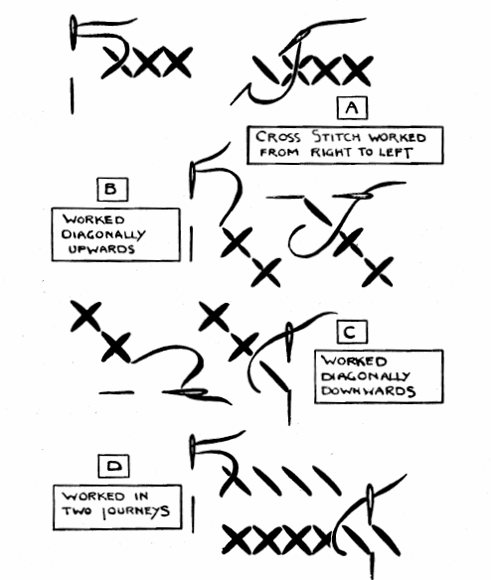
FIG. 1. METHOD OF WORKING CROSS STITCH
shows the correct method of working the basic stitch
A. Worked from right to left, each stitch completed before the next is begun.
B. Worked diagonally upwards.
C. Worked diagonally downwards. The diagonal method of working cross stitch gives an even all-over tension, and should always be used when filling in the background of Assisi embroidery.
D. Cross stitch worked in two journeys. This method is sometimes used when blocks and long rows of filling stitches are being worked in one colour. It is a much quicker way of covering the ground, but the tension of the stitch is not so regular and the finished needlework will not be so even.
This is a decorative powdering stitch and gives a pleasant variety when used with simple cross stitch. illustrates a geometrical pattern worked entirely in double cross stitch.
sets out two methods of working double cross stitch
A. Worked to fill a square. Here the St. Andrews cross is worked first and the Greek cross is superimposed.
B. Worked to fill a diamond. The order of making the crosses is reversed, and the St. Andrews cross is smaller.
This is the finest stitch used in canvas embroidery and is frequently combined with cross stitch in eighteenth-century tapestry work. It may be used to fill in the more delicate details of the pattern, the faces and hands perhaps, of the tiny figures that wander through each thickly wooded landscape.

FIG. 2. TWO METHODS OF WORKING DOUBLE CROSS STITCH

FIG. 3. METHOD OF WORKING TENT STITCH
illustrates the method of working the tent stitch.
A. First row, the needle, working diagonally, picks up two threads with each movement, but the stitch made covers only one crossed thread.
B. On the return journey, the needle, inserted vertically, picks up two threads in the spaces left by the first row of stitches.
This is a useful outline stitch worked in two journeys. It is combined with cross stitch in Assisi embroidery, outlining the pattern and the solid groups of stitches, and is used to suggest the lines of a wing feather, or an eye, on the unworked linen of the design.

Font size:
Interval:
Bookmark:
Similar books «Cross Stitch Patterns»
Look at similar books to Cross Stitch Patterns. We have selected literature similar in name and meaning in the hope of providing readers with more options to find new, interesting, not yet read works.
Discussion, reviews of the book Cross Stitch Patterns and just readers' own opinions. Leave your comments, write what you think about the work, its meaning or the main characters. Specify what exactly you liked and what you didn't like, and why you think so.

